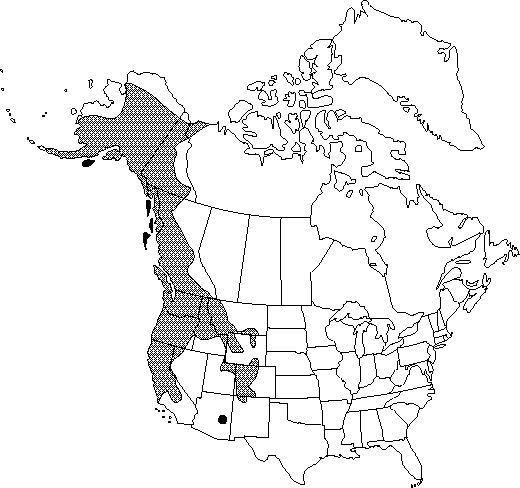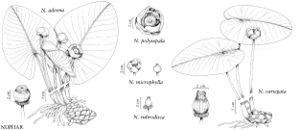Difference between revisions of "Nuphar polysepala"
Trans. Acad. Sci. St. Louis 2: 282. 1865 (as polysepalum).
FNA>Volume Importer |
imported>Volume Importer |
||
| (7 intermediate revisions by 2 users not shown) | |||
| Line 7: | Line 7: | ||
}} | }} | ||
|special_status={{Treatment/ID/Special_status | |special_status={{Treatment/ID/Special_status | ||
| + | |code=W1 | ||
| + | |label= | ||
| + | }}{{Treatment/ID/Special_status | ||
|code=E | |code=E | ||
|label=Endemic | |label=Endemic | ||
}}{{Treatment/ID/Special_status | }}{{Treatment/ID/Special_status | ||
|code=F | |code=F | ||
| − | |label= | + | |label=Illustrated |
| − | |||
| − | |||
| − | |||
}} | }} | ||
|basionyms= | |basionyms= | ||
|synonyms={{Treatment/ID/Synonym | |synonyms={{Treatment/ID/Synonym | ||
| − | |name= | + | |name=Nuphar lutea subsp. polysepala |
|authority=(Endelmann) E. O. Beal | |authority=(Endelmann) E. O. Beal | ||
| − | }}{{Treatment/ID/Synonym | + | |rank=subspecies |
| − | |name= | + | }} {{Treatment/ID/Synonym |
| + | |name=Nymphaea polysepala | ||
|authority=(Engelmann) Greene | |authority=(Engelmann) Greene | ||
| + | |rank=species | ||
}} | }} | ||
|hierarchy=Nymphaeaceae;Nuphar;Nuphar polysepala | |hierarchy=Nymphaeaceae;Nuphar;Nuphar polysepala | ||
| Line 31: | Line 33: | ||
}}<!-- | }}<!-- | ||
| − | --><span class="statement" id="st- | + | --><span class="statement" id="st-undefined" data-properties=""><b>Rhizomes </b>3-8 cm diam. <b>Leaves</b> mostly floating, occasionally emersed or submersed; petiole terete. <b>Leaf</b> blade abaxially and adaxially green, widely ovate, 10-40(-45) × 7-30 cm, ca. 1.2-1.5 times as long as wide, sinus 1/3-2/3 length of midrib, lobes divergent to overlapping; surfaces glabrous. <b>Flowers</b> 5-10 cm diam.; sepals mostly (6-)9(-12), abaxially green to adaxially yellow, sometimes red-tinged toward base; petals oblong, thick; anthers 3.5-9 mm, slightly shorter than filaments. <b>Fruit</b> green to yellow, cylindric to ovoid, 4-6(-9) × 3.5-6 cm, strongly ribbed, slightly constricted below stigmatic disk; stigmatic disk green, 20-35 mm diam., entire to crenate; stigmatic rays 8-26(-36), linear to lanceolate, terminating within 1(-1.5) mm from margin of disk. <b>Seeds</b> 3.5-5 mm. <b>2n</b> = 34.</span><!-- |
-->{{Treatment/Body | -->{{Treatment/Body | ||
| Line 38: | Line 40: | ||
|elevation=0-3700 m | |elevation=0-3700 m | ||
|distribution=B.C.;N.W.T.;Yukon;Alaska;Ariz.;Calif.;Colo.;Idaho;Mont.;Nev.;N.Mex.;Oreg.;Utah;Wash.;Wyo. | |distribution=B.C.;N.W.T.;Yukon;Alaska;Ariz.;Calif.;Colo.;Idaho;Mont.;Nev.;N.Mex.;Oreg.;Utah;Wash.;Wyo. | ||
| − | |discussion=<p>Plants intermediate between Nuphar polysepala and N. variegata occur in eastern British Columbia.</p> | + | |discussion=<p>Plants intermediate between <i>Nuphar polysepala</i> and <i>N. variegata</i> occur in eastern British Columbia.</p> |
|tables= | |tables= | ||
|references= | |references= | ||
| Line 47: | Line 49: | ||
-->{{#Taxon: | -->{{#Taxon: | ||
name=Nuphar polysepala | name=Nuphar polysepala | ||
| − | |||
|authority=Engelmann | |authority=Engelmann | ||
|rank=species | |rank=species | ||
|parent rank=genus | |parent rank=genus | ||
| − | |synonyms= | + | |synonyms=Nuphar lutea subsp. polysepala;Nymphaea polysepala |
|basionyms= | |basionyms= | ||
|family=Nymphaeaceae | |family=Nymphaeaceae | ||
| Line 61: | Line 62: | ||
|publication title=Trans. Acad. Sci. St. Louis | |publication title=Trans. Acad. Sci. St. Louis | ||
|publication year= | |publication year= | ||
| − | |special status=Endemic; | + | |special status=W1;Endemic;Illustrated |
| − | |source xml=https:// | + | |source xml=https://bitbucket.org/aafc-mbb/fna-data-curation/src/2e0870ddd59836b60bcf96646a41e87ea5a5943a/coarse_grained_fna_xml/V3/V3_672.xml |
|genus=Nuphar | |genus=Nuphar | ||
|species=Nuphar polysepala | |species=Nuphar polysepala | ||
| − | |||
| − | |||
| − | |||
| − | |||
| − | |||
| − | |||
| − | |||
| − | |||
| − | |||
| − | |||
| − | |||
| − | |||
| − | |||
| − | |||
| − | |||
| − | |||
| − | |||
| − | |||
| − | |||
| − | |||
| − | |||
| − | |||
| − | |||
| − | |||
| − | |||
| − | |||
| − | |||
| − | |||
| − | |||
| − | |||
| − | |||
| − | |||
| − | |||
| − | |||
| − | |||
}}<!-- | }}<!-- | ||
-->[[Category:Treatment]][[Category:Nuphar]] | -->[[Category:Treatment]][[Category:Nuphar]] | ||
Latest revision as of 21:50, 5 November 2020
Rhizomes 3-8 cm diam. Leaves mostly floating, occasionally emersed or submersed; petiole terete. Leaf blade abaxially and adaxially green, widely ovate, 10-40(-45) × 7-30 cm, ca. 1.2-1.5 times as long as wide, sinus 1/3-2/3 length of midrib, lobes divergent to overlapping; surfaces glabrous. Flowers 5-10 cm diam.; sepals mostly (6-)9(-12), abaxially green to adaxially yellow, sometimes red-tinged toward base; petals oblong, thick; anthers 3.5-9 mm, slightly shorter than filaments. Fruit green to yellow, cylindric to ovoid, 4-6(-9) × 3.5-6 cm, strongly ribbed, slightly constricted below stigmatic disk; stigmatic disk green, 20-35 mm diam., entire to crenate; stigmatic rays 8-26(-36), linear to lanceolate, terminating within 1(-1.5) mm from margin of disk. Seeds 3.5-5 mm. 2n = 34.
Phenology: Flowering spring (later in north)-summer.
Habitat: Ponds, lakes, and sluggish streams
Elevation: 0-3700 m
Distribution

B.C., N.W.T., Yukon, Alaska, Ariz., Calif., Colo., Idaho, Mont., Nev., N.Mex., Oreg., Utah, Wash., Wyo.
Discussion
Plants intermediate between Nuphar polysepala and N. variegata occur in eastern British Columbia.
Selected References
None.
